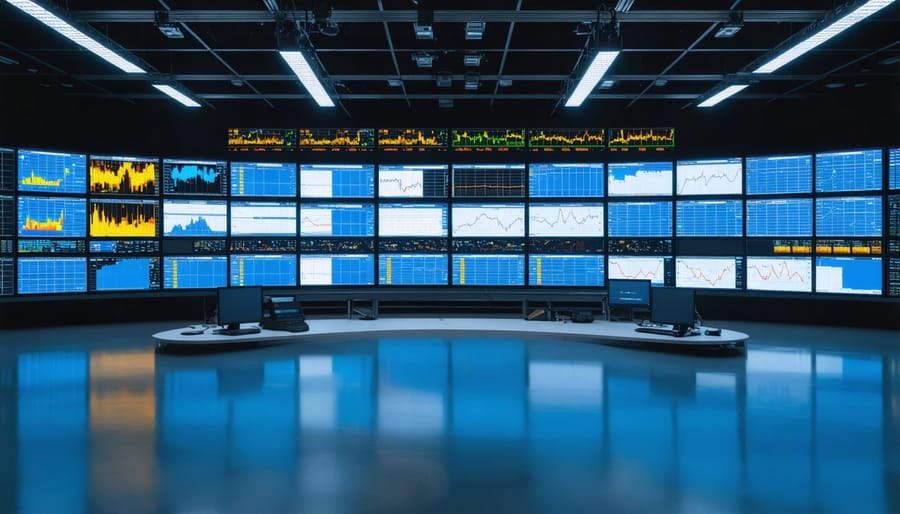Energy trading software has revolutionized how organizations monetize their solar investments and benefits your bottom line. Advanced algorithms now enable real-time optimization of energy sales, automated bidding strategies, and precise demand forecasting—capabilities that were impossible just a decade ago.
Modern energy trading platforms integrate seamlessly with existing solar infrastructure to maximize revenue potential through sophisticated price analysis and automated trading execution. These systems leverage artificial intelligence to identify optimal selling windows, manage risk exposure, and capitalize on market volatility while ensuring regulatory compliance.
For facility managers and energy professionals, implementing the right trading software can transform solar installations from simple cost-saving measures into profitable revenue centers. Leading organizations report ROI improvements of 15-30% after deploying advanced trading solutions, demonstrating the transformative potential of these technologies in today’s dynamic energy marketplace.
The key to success lies in selecting platforms that combine robust analytical capabilities with intuitive interfaces, ensuring both technical precision and operational efficiency. This strategic approach to energy trading has become essential for organizations seeking to maximize their renewable energy investments.

How Digital Platforms Transform Solar Energy Trading
Real-Time Energy Market Integration
Energy trading software platforms integrate seamlessly with real-time energy markets through sophisticated APIs and dedicated data feeds, enabling instantaneous trading capabilities across multiple exchanges and territories. These systems process vast amounts of market data, including pricing, demand forecasts, and grid conditions, to execute trades within milliseconds.
The integration typically operates through secure, encrypted connections to major energy exchanges, ISO/RTOs, and bilateral trading platforms. Advanced algorithms continuously monitor market conditions, automatically identifying profitable trading opportunities while maintaining compliance with regulatory requirements.
Modern platforms feature customizable dashboards that display real-time market data, position tracking, and risk management metrics. Users can set automated trading parameters based on predefined conditions, such as price thresholds or weather forecasts, ensuring optimal execution of energy trades without constant manual intervention.
These systems also facilitate participation in ancillary service markets, allowing energy producers to maximize revenue through frequency regulation, capacity markets, and demand response programs. The software’s ability to aggregate data from multiple sources and execute trades rapidly has become essential for competitive advantage in today’s dynamic energy markets.
Automated Trading Features
Modern energy trading software leverages sophisticated AI algorithms and automation capabilities to optimize trading decisions and maximize returns. These systems continuously analyze market data, weather patterns, and energy consumption trends to execute trades at optimal price points.
Key automated features include predictive analytics that forecast energy demand and supply variations, automatic order execution based on pre-set parameters, and real-time portfolio rebalancing. Smart algorithms can identify profitable trading opportunities within milliseconds, responding to market fluctuations faster than manual trading allows.
Risk management automation is another crucial component, with systems implementing stop-loss orders and position limits automatically. Many platforms offer customizable trading strategies that can be back-tested using historical data before deployment in live markets.
Advanced platforms incorporate machine learning capabilities that adapt to changing market conditions and improve performance over time. These systems can automatically adjust trading parameters based on performance metrics and market volatility, ensuring consistent returns while minimizing risk exposure.
For facility managers and energy providers, these automated features translate into reduced operational costs, improved efficiency, and more predictable revenue streams from energy trading activities.

Key Benefits for Commercial Solar Users
Maximum Revenue Generation
Energy trading software employs sophisticated algorithms and real-time market analysis to help organizations maximize clean energy ROI through strategic selling decisions. The software continuously monitors energy market conditions, demand patterns, and pricing fluctuations to identify optimal selling opportunities.
By analyzing historical data and current market trends, these platforms determine the most profitable times to sell excess solar energy back to the grid. The software considers multiple variables, including peak demand periods, weather forecasts, and regional energy prices, to automatically adjust selling strategies for maximum revenue generation.
Advanced forecasting capabilities enable users to predict high-demand periods when energy prices typically surge, allowing them to store energy during low-price periods and sell during peak pricing windows. The software also factors in grid requirements, regulatory compliance, and transmission constraints to ensure reliable and profitable energy trading operations.
Real-time price optimization features automatically adjust selling prices based on market conditions, helping organizations capitalize on short-term price spikes while maintaining long-term profitability. The system can also coordinate with energy storage systems to optimize the timing of energy releases, ensuring maximum financial returns while maintaining grid stability and meeting contractual obligations.
This automated approach to energy trading typically yields 15-30% higher returns compared to manual trading strategies, while reducing the operational overhead associated with energy market participation.
Risk Management Tools
Modern energy trading software incorporates sophisticated risk management strategies to protect organizations from market volatility and financial exposure. These tools typically include real-time position monitoring, automated stop-loss mechanisms, and advanced analytics for risk assessment.
Key features include Value at Risk (VaR) calculations, which help traders quantify potential losses under various market scenarios. Monte Carlo simulations provide comprehensive risk analysis by modeling thousands of possible market outcomes, enabling better-informed trading decisions.
Credit risk management modules assess counterparty reliability and automatically enforce trading limits, while mark-to-market capabilities offer instant portfolio valuation. Many platforms also incorporate stress testing functions to evaluate portfolio performance under extreme market conditions.
Advanced algorithmic trading tools help maintain predetermined risk levels by automatically adjusting positions based on market movements. These systems can execute complex hedging strategies across multiple energy markets simultaneously, protecting against price fluctuations in related commodities.
Modern platforms also feature customizable alert systems that notify traders when positions approach risk thresholds, enabling prompt corrective action. Integration with regulatory compliance systems ensures all trading activities adhere to industry standards while maintaining comprehensive audit trails for risk oversight.
Implementation Success Story
GreenTech Solutions, a mid-sized commercial solar developer managing multiple solar installations across the Southwest United States, implemented an advanced energy trading platform in 2021 with remarkable results. Within the first year of deployment, the company reported a 32% increase in revenue from their energy trading operations and a 45% improvement in operational efficiency.
The company previously struggled with manual trading processes and delayed response times to market fluctuations. After implementing an AI-powered energy trading software solution, they were able to automate 85% of their trading decisions and respond to market changes in real-time. The platform’s predictive analytics capabilities enabled them to forecast energy demand patterns with 94% accuracy, leading to optimized trading strategies and enhanced profit margins.
A key success factor was the software’s ability to integrate with their existing solar monitoring systems and grid infrastructure. The platform processed data from 50,000 solar panels across 12 installations, providing comprehensive insights into production patterns and potential maintenance issues. This integration resulted in a 28% reduction in maintenance costs and a 15% increase in overall system efficiency.
The ROI was particularly impressive, with the initial investment in the trading software recovered within eight months. The automated trading algorithms executed more than 10,000 trades in the first year, capturing optimal prices during peak demand periods and managing excess supply during off-peak hours. The system’s risk management features also helped reduce trading losses by 40% compared to their previous manual trading approach.
Today, GreenTech Solutions uses the platform to manage an energy portfolio worth over $50 million, with plans to expand their operations by an additional 30% in the coming year. Their success demonstrates how modern energy trading software can transform solar energy operations from a simple power generation business into a sophisticated energy trading enterprise.

Choosing the Right Platform
Essential Features Checklist
A robust energy trading software platform must incorporate several key features to effectively manage commercial solar operations. Real-time monitoring and analytics capabilities are essential for tracking energy generation, consumption, and market prices. The platform should offer automated trading functionality with customizable algorithms to optimize buy/sell decisions based on predefined parameters.
Comprehensive forecasting tools that integrate weather data, historical performance metrics, and market trends are crucial for accurate energy production predictions. The software must include secure payment processing and settlement systems to handle financial transactions efficiently.
Advanced reporting capabilities should provide detailed insights into performance metrics, financial returns, and regulatory compliance. Integration capabilities with existing energy management systems and smart grid infrastructure are vital for seamless operations.
Data security features, including encryption and access controls, protect sensitive trading information and ensure regulatory compliance. The platform should also offer scalable architecture to accommodate growing energy portfolios and changing market conditions.
Mobile accessibility and real-time alerts enable quick response to market opportunities and system issues, while user-friendly dashboards make complex data easily digestible for stakeholders at all levels.
Energy trading software has become an indispensable tool in the modern energy landscape, transforming how organizations manage, trade, and optimize their energy resources. As the energy sector continues to evolve with increasing renewable integration and market complexity, these sophisticated platforms offer the strategic advantage needed to stay competitive and efficient.
The implementation of energy trading software represents a significant step toward achieving both operational excellence and sustainability goals. Organizations considering adoption should begin with a thorough assessment of their current energy management practices, followed by careful evaluation of available solutions that align with their specific needs and objectives.
Success in implementation requires a structured approach: securing stakeholder buy-in, establishing clear implementation timelines, providing comprehensive staff training, and ensuring robust technical support. Organizations should also consider starting with pilot programs before full-scale deployment to minimize risks and optimize outcomes.
Looking ahead, energy trading software will continue to evolve with advancing technologies like artificial intelligence, blockchain, and improved analytics capabilities. Organizations that embrace these solutions now will be better positioned to adapt to future market changes and capitalize on emerging opportunities in the energy sector.
By investing in energy trading software today, organizations can build a foundation for more efficient, profitable, and sustainable energy operations while maintaining competitive advantage in an increasingly complex energy marketplace.

